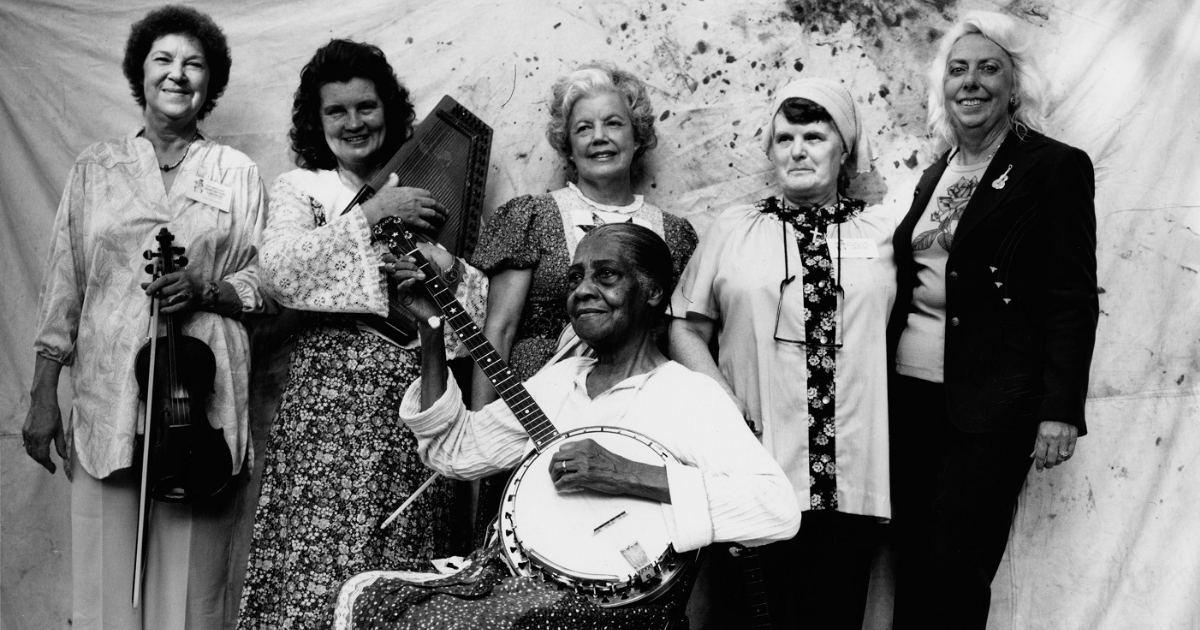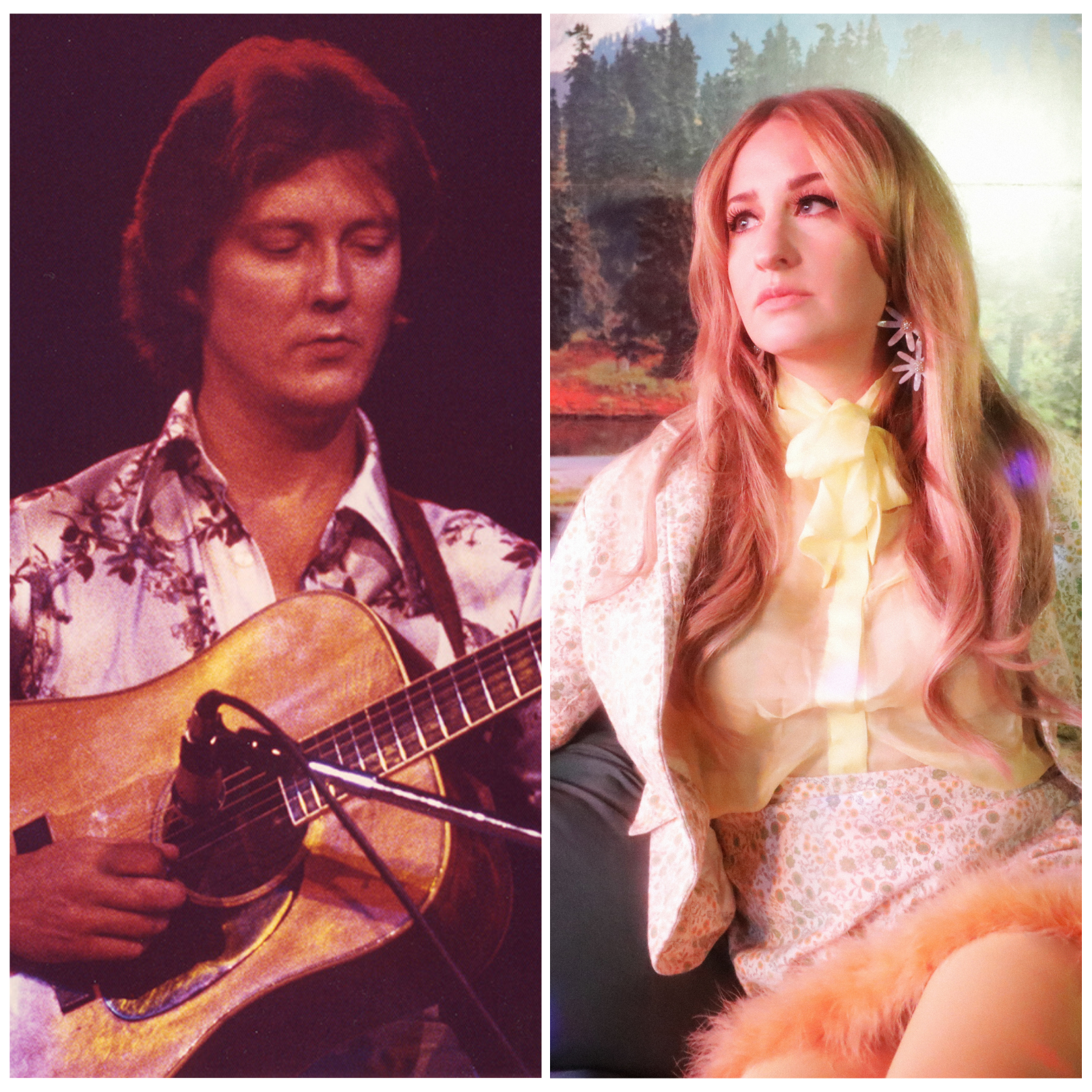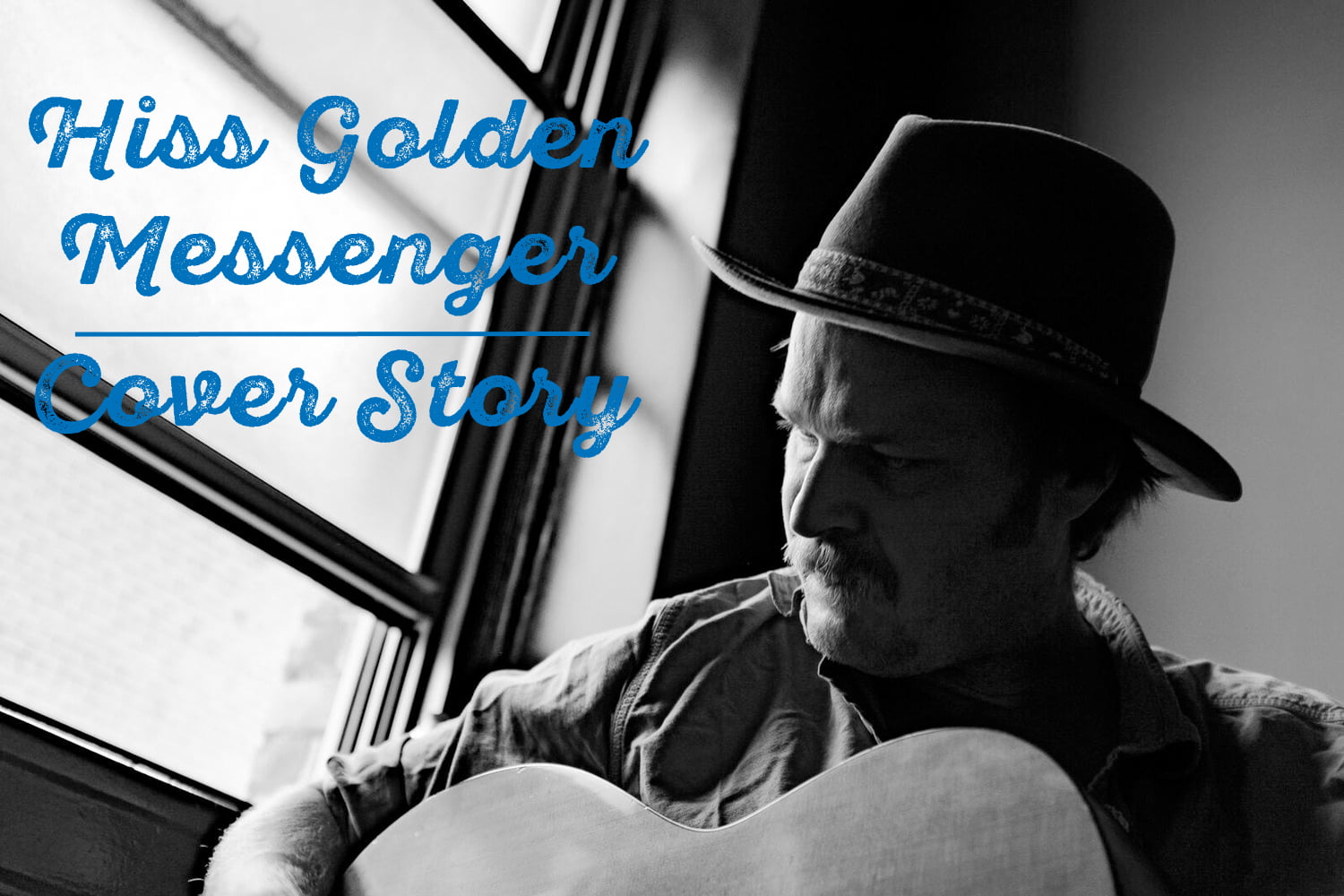It is immediately apparent upon stepping into a new special exhibit at the Birthplace of Country Music Museum that the contributions of women in old-time music are all-encompassing. From winning fiddle contests to writing timeless songs to working behind the scenes, women have made a mark on every corner of the old-time landscape. And they continue to do so, as evidenced by the exhibit’s title, I’ve Endured: Women in Old-Time Music.
On display through the end of 2023 inside this Bristol, Tennessee-Virginia, destination, the exhibit is rooted in history but undoubtedly feels topical. Through photos, video interviews, panels and artifacts, it tells a story that’s as relevant today as it was in the 1920s — or at any point in between. The exhibit was curated by a content team of curatorial staff and external experts led by Dr. Rene Rodgers, the museum’s head curator; a companion website enhances the narrative and will support the exhibit when it travels.
Toni Doman-Vandyke, the museum’s grant coordinator and curatorial specialist who also hosts a program on WBCM-LP Radio Bristol, the museum’s in-house radio station, observes, “Historically, women have had many challenges and have even faced restrictions on the songs they were allowed to sing. And that can also connect with early barn dance radio and record producers making decisions about what a performer — in this case, women — would look like. That can be everything from their costumes to how they’re portrayed. Their record producers really made assumptions on how an audience would perceive women. So, a woman is up there and she needs to be morally good, right? It’s the 1930s, it’s the Depression. We don’t want her singing these sad songs. Producers would often say, ‘You’re gonna sing this and it’s gonna sound this way.’ It took a long time for women to get their own voice out there.”
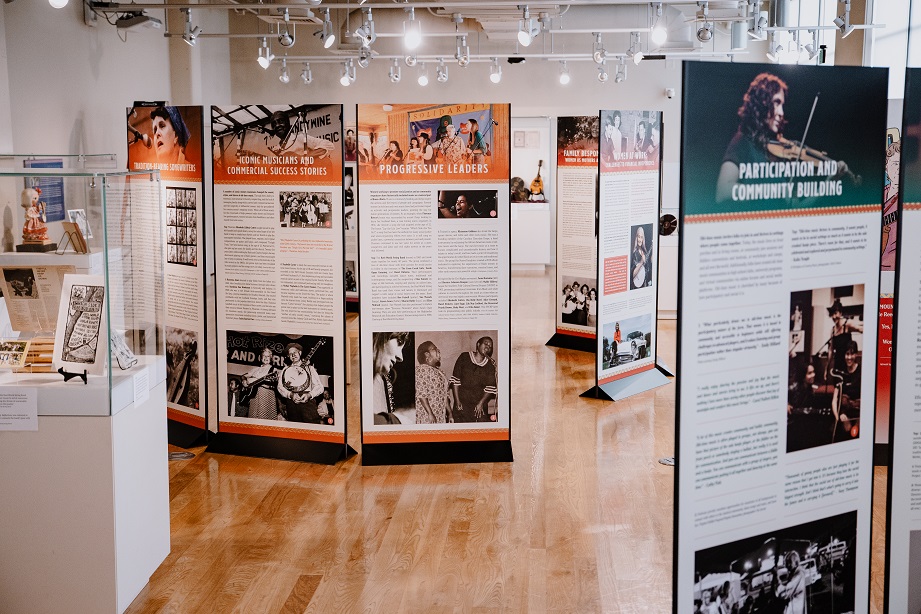
Erika Barker, the museum’s curatorial manager, adds, “In a lot of cases, it was men writing songs for women, and what they thought women were thinking or should be thinking, instead of women being able to write their own songs or record the songs that they had written.”
Experiencing the exhibit is fascinating if not slightly frustrating. Time and again, women were asked to adapt rather than embrace their creative identity, sometimes in a literal sense. For example, when John Lair envisioned an all-girl string band he’d call the Coon Creek Girls, he allowed fiddler player and radio star Lily May Ledford and her sister, guitarist Rosie Ledford, to keep their floral names and their Kentucky roots. However, to further feminize the group and underscore the rural origins, mandolinist Esther Koehler became “Violet” and Evelyn Lange assumed the role of “Daisy” (but first had to teach herself to play bass); their hometowns in Indiana and Ohio, respectively, were scrubbed from the story. All four women were presented as hailing from a holler in Kentucky — a completely fictional place.
Following a self-guided tour of the special exhibit, BGS spoke with Barker and Doman-Vandyke about the surprises they encountered while creating the exhibit as well as the lesser-known stories that they’re eager to share.
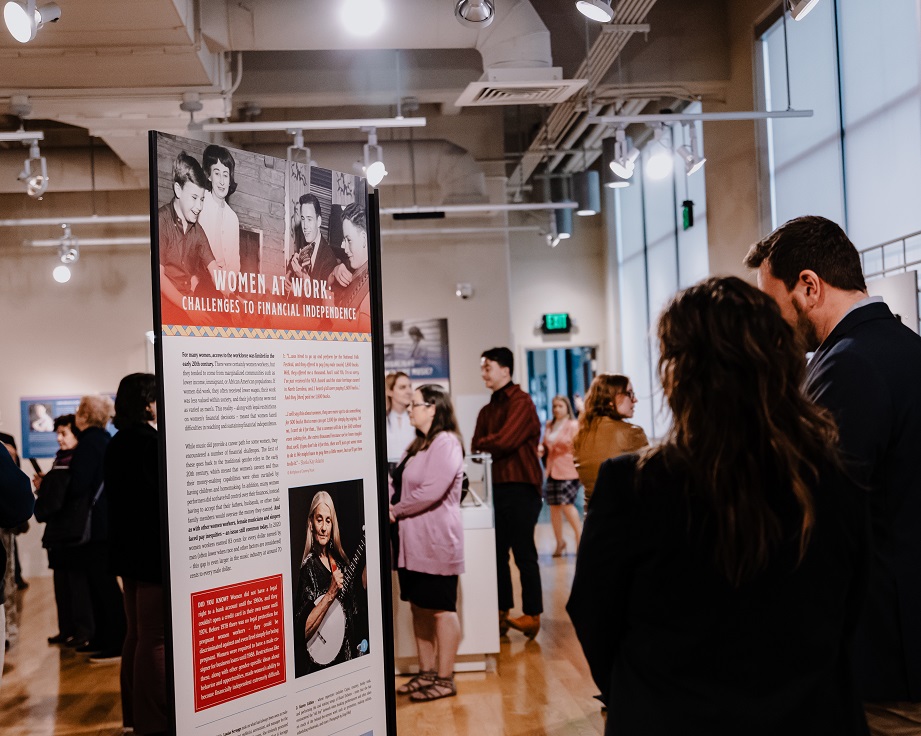
BGS: Since this is a topic that hasn’t often been explored, it seems that you could make this exhibit into whatever you wanted it to be. What got you the most excited about the process?
Doman-Vandyke: It’s not just names of people and dates. We really wanted to dive into those stories of women and I think we’ve done a really good job of that, really highlighting those hidden histories. And another thing we wanted to focus on was not just doing the big names. OK, we have a lot of well-known names in the exhibit of course, but we’re trying to uncover those hidden histories in those stories and people who might not have ever made it on the mainstream.
Of course, Ola Belle Reed is a huge name and a great influence in old-time music. Rhiannon Giddens, who is in the exhibit, is a huge innovator of old-time music and beyond. But in this exhibit we feature stories like Roni Stoneman’s. She has a great story where she was the only woman in a banjo contest, and she wasn’t allowed to be the winner even though she was the clear winner. All the judges said, “We can’t let a girl win this contest.” Another story that I really like in the exhibit is Sally Ann Forrester, who was the first woman to play in Bill Monroe’s band, although she was not seriously credited as being a musician because she was a woman. She was thought of by the public as just filling in for her husband, who was also a musician in Monroe’s band. And that was not the case!
Barker: One of my favorite “hidden women” in the exhibit is Dr. Katherine Jackson French, who was an early song collector. She tried to get her collection of Kentucky ballads published several years before Cecil Sharp published his famous ballad collection, but they were never published. About 110 years later, they’ve now been published. I found her story fascinating and I got invested in her while doing research for the exhibit. There are so many women like that, that were doing the work and moving the genre forward, and yet we don’t really know a lot of their names.
View this post on Instagram
Doman-Vandyke: I also have to mention Elsie McWilliams as another really hidden story that spoke to me because she wrote dozens of songs for Jimmie Rodgers. Before we started doing research for this, I thought Jimmie Rodgers just wrote all his songs. I had no idea that he had someone that wrote for and with him, and yet she isn’t well-known for this achievement. In the interviews that we read, and as we uncovered information about her, she was kind of like, “I’ll just write them because he’s my brother-in-law.” She had a personal connection to Jimmie Rodgers, but she was a phenomenal piano player and songwriter. She’s actually known as one of the first women to make a career out of songwriting in country music and yet her story isn’t out there very much. Featuring these types of stories was really our goal when we all put this together.
Barker: Roba Stanley is another one that I liked that is not super well-known. She was one of the earliest women to record old-time music and is known as “The first sweetheart of country music,” but her career only lasted about a year. She even had a song called “Single Girl” that included the lyrics “Single life is a happy life! Single life is lovely! I am single and no man’s wife. And no man shall control me.” Then she got married, sold her guitar, moved, and never recorded again because her husband didn’t want her to perform publicly, which was not uncommon. But she was very successful for only having a few recordings out, and then she completely walked away from it when she got married.
Doman-Vandyke: Louise Scruggs is also a great example. She was Earl Scruggs’ wife and one of the first touring and booking managers in country music, not just old-time music. She had a huge career. Every time I’m in Nashville, I love to visit Spring Hill Cemetery because so many musicians are buried there. It’s great to just walk around and learn about history. We saw her gravestone there at the front and something that’s great about it is that all of her achievements were listed on her tombstone. And it wasn’t just, “Wife of Earl Scruggs,” which I thought was amazing.
I noticed Amythyst Kiah in a few places in the exhibit. What was it about her story that fits so well into this exhibit?
Barker: She has a special place in the heart of this museum in particular because she was a part of the original content team when the museum was being created. She lives in this area and is an alumna of East Tennessee State University’s Bluegrass, Old-Time and Country Music Studies program in the Department of Appalachian Studies. We love reconnecting with her and she’s got such a great background in this type of music, and is also Grammy-nominated and doing amazing things. She’s a great example of exactly what we’re talking about in the exhibit of women innovating and pushing boundaries with music today.
Doman-Vandyke: Getting interested in old-time music was part of her roots and now she’s still paying homage to those roots but taking it in an innovative direction. That’s another thing we feature in the exhibit – old-time music is not just this one sound that has parameters around it. Old-time music has always been innovative. It’s always been influenced by the players around it. It’s always had different influences throughout time. Many of our interviewees touched on that point. I feel it’s important to preserve roots and branches of this music, but it’s also important to innovate and adapt for modern audiences. Old-time music especially is community oriented. It’s participatory and very welcoming, and all of those factors play into its innovation, its longevity, and where it’s going and how it’s being preserved and promoted.
Barker: One of the things we wanted people to see in the exhibit is that this music has multiple influences and connections, its history is rooted in different cultural influences, and there’s a place in this music for everybody.
View this post on Instagram
This is going to be a traveling exhibit. What kind of message do you hope to spread as it goes out beyond East Tennessee and Appalachia?
Barker: Highlighting the fact that women have always been a part of this music and not just in the background. They’ve been moving the music forward, they’ve been innovating. They’ve been the ones, in a lot of cases, carrying on that culture and tradition, because especially in earlier days, women were seen as the community tradition-bearers. We’re showcasing how that has continued and how they continue to innovate. We’re giving a little bit more information on some of the stories and the women that you have heard about, and also introducing people to women they’ve never heard about and looking at why they might not have heard of those women — and why they should.
Doman-Vandyke: Something I would like people to take away from the exhibit is better understanding the barriers to success that women had. Women have historically not had as many opportunities as men to be successful in their own career. So many challenges that women face are women specific issues, like pregnancy and family responsibilities. There are stories where women have gotten pregnant and they aren’t able to continue performing. This still happens today.
Barker: Even today, there’s often no daycare at a festival or concert venue, even for the performers. It’s just not set up for motherhood and it was even more challenging during the earlier days, when it was less socially acceptable for a woman to even be on stage or be in the room. If a woman was at a bar, or somewhere music is being played, a lot of times there were assumptions made about her role there, or her role in the band. It’s not usually assumed that she’s the leader of the band —often she isn’t even assumed to be a real member of the band — and it’s certainly not socially acceptable for her to bring children with her, unless they were part of the act. Some people like the Carter Family did often take their children with them and find ways to share the stage with them as part of the act. But a lot of women weren’t either able or willing to do that, so that limits where they can travel and where they can play and how often they can play.
Here’s a philosophical question for you. What surprised you the most as this was coming together?
Doman-Vandyke: What has surprised me the most is just how many challenges are still prevalent. When we were talking to all of our interviewees, they touched on that: “Hey, we’ve come a long way historically but we’re still not there yet.” Every one of our interviewees made that point really clear that we still have a long way to go, where we’re getting to equity.
Barker: I did like that they were all pretty optimistic. That was reassuring. But I think that was probably one of the things that surprised me, too. I’d like to think of a lot of these issues as being in the past, and well, maybe to some degree, they are. But they’re certainly not all in the past. Especially wage disparity. And that’s across all sectors, not just music.
Doman-Vandyke: These challenges and issues that women face that we featured in the exhibit aren’t just specific to old-time music. You could pick up the themes in this exhibit and put it into any genre of music and still have the same challenges women face, whether that’s rock ‘n’ roll, whether that’s country music. I mean, even take music out of it and women are still facing all of these issues. I hope this exhibit brings awareness to the challenges women in old-time music and adjacent genres have historically faced and also brings excitement to visitors in learning about these incredible women.
Main Image – From the Mike Seeger Collection (Series Addition of June 2011: Photographs ca. 1950—2000), #20009, Southern Folklife Collection, Wilson Library, University of North Carolina at Chapel Hill. Pictured, standing (L-R): Lily May Ledford, Janette Carter, Ramona Jones, Ola Belle Reed, Rose Maddox. Seated: Elizabeth Cotten. Gallery Photos – © Birthplace of Country Music; photographer: Ashli Linkous
